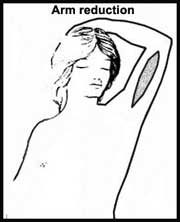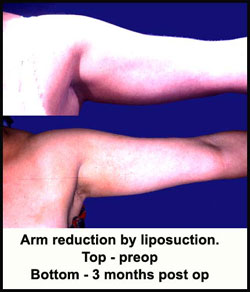Concern about large, bulky upper arms has brought many patients to our Center over the years. Many have been discouraged by the need for long incisions required in classical arm reduction techniques. Newer techniques of liposuction have allowed us to successfully treat many of these patients without these incisions.
Patients seeking arm reduction are concerned about excess fat in the upper arms, loose skin, or a combination of both. Traditional arm reduction techniques required long incisions that were made down the medial aspect of the arm as shown in the diagram. Effort was made to place the incision in the most hidden portion of the arm, but since the arm is always being rotated, it is impossible to completely hide the scar. While great care is made to close the incision as carefully as possible, using several layers of closure with a final skin layer of fine absorbable suture, thickened or wide scars are still possible.
For a patient with very saggy skin in the upper arms, the resulting scar from surgery is often an acceptable trade off. But what about patients whose skin is somewhat loose and whose main problem is excess fat. In the past, arm reduction was the only alternative. Liposuction techniques were considered too crude to be used on the arms for fear of uneven reduction, lumpiness or skin injury. All of this has changed with improvements in liposuction techniques.
 With the advent of fine cannula liposuction, combined with the infiltration of a “tumescent” solution of saline (salt water) containing medications to constrict blood vessels and numb the tissues, surgeons can now safely remove fat in the arms without undue risk of unpleasant side effects. The thin cannulas used today allow us to work immediately beneath the skin, which allows more precise and even fat removal. An added advantage is the fact that by working just beneath the skin, there is often better skin shrinkage, which can help reverse the sagging, loose skin.
With the advent of fine cannula liposuction, combined with the infiltration of a “tumescent” solution of saline (salt water) containing medications to constrict blood vessels and numb the tissues, surgeons can now safely remove fat in the arms without undue risk of unpleasant side effects. The thin cannulas used today allow us to work immediately beneath the skin, which allows more precise and even fat removal. An added advantage is the fact that by working just beneath the skin, there is often better skin shrinkage, which can help reverse the sagging, loose skin.
Of course there are limitations. Patients with a great deal of skin sag or those with poor skin elasticity may not achieve satisfactory results with liposuction alone and may still require skin excision. Even in these cases, where the two techniques are combined, the results are superior to older types of arm reduction. Some of our patients have decided to try liposuction alone, recognizing that skin excision may later be required, but to my recollection, none have later opted for the skin removal.
Both procedures are normally carried out under general anesthesia, although local anesthesia would be an option. Postoperative care consists of the use of an arm wrap for several weeks, but there is no significant limitation on activity. Final results are not apparent for several weeks, and swelling can persist for a few months. When the classic reduction is carried out, it takes many months for the scar to mature.
Liposuction is not a replacement for traditional arm reduction, but it certainly has broadened horizons for the management of unsightly upper arms. Now, at least for many patients, there is an option that avoids significant scarring.


